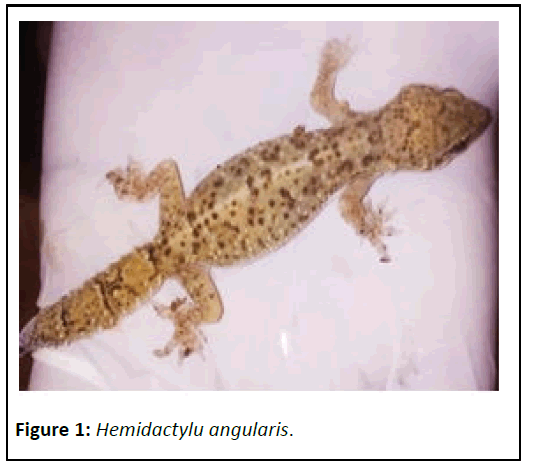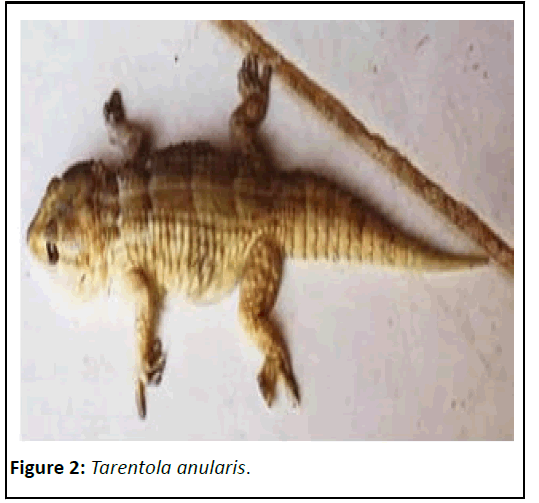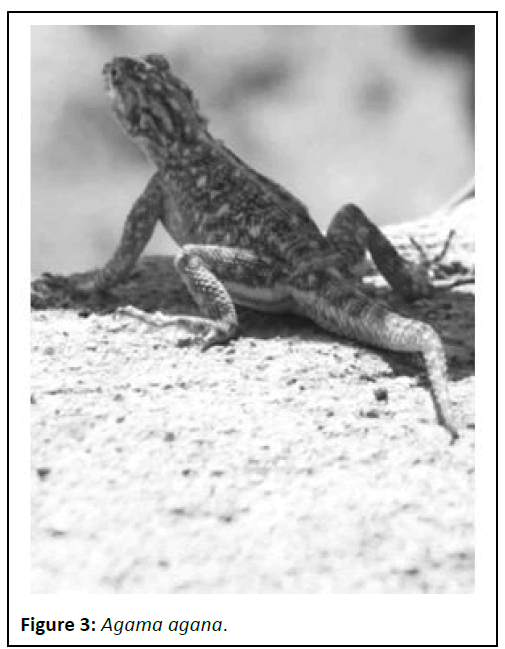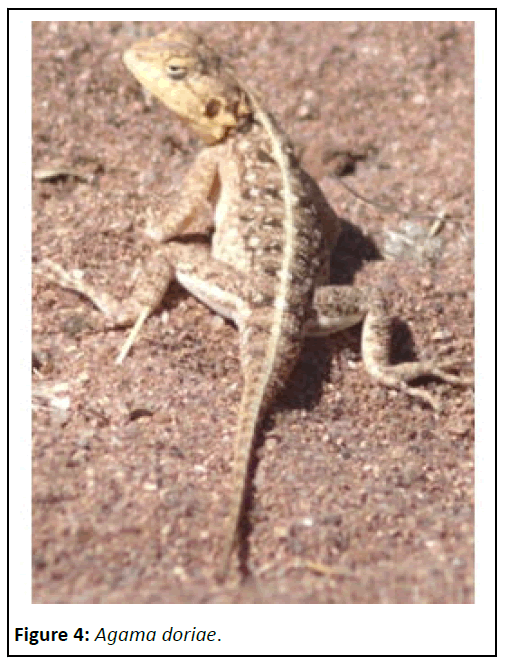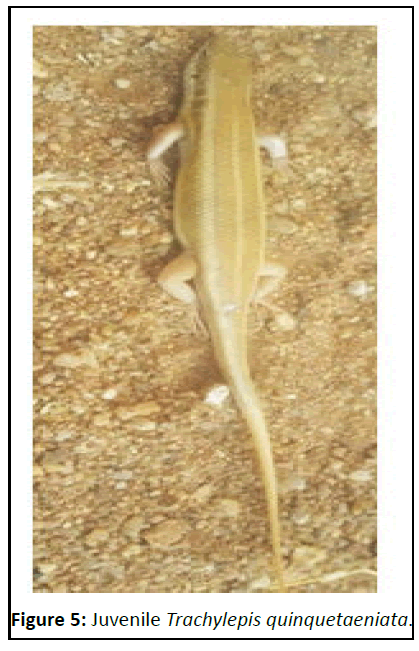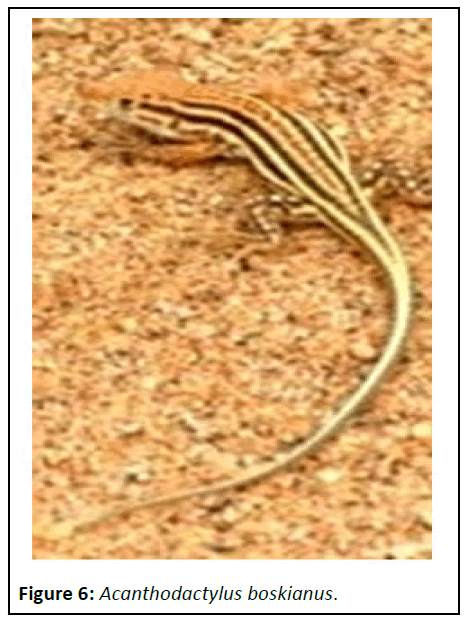ISSN : 2348-1927
Annals of Biological Sciences
Abundance of Lacertilians in Relation to Elevation and Vegetation in Jebel Al Dayer Biosphere Reserve, North Kordofan State
Zuheir N Mahmoud1*, Mohamed A Abd El-Rahman3 and Mohamed AA Salih2
1Department of Zoology, University of Khartoum, Khartoum, Sudan
2Department of Zoology, University of Khordofan, El Obeid, Sudan
3Department of History, University of Khartoum, El Obeid, Sudan
- *Corresponding Author:
- Zuheir N Mahmoud
Department of Zoology,
University of Khartoum,
Khartoum,
Sudan;
Email: zuheirnm@hotmail.com
Received: April 26, 2023, Manuscript No. ABS-23-16507; Editor assigned: May 02, 2023, PreQC No. ABS-23-16507 (PQ); Reviewed: May 16, 2023, QC No. ABS-23-16507; Revised: May 17, 2023, Manuscript No. ABS-23-16507 (R); Published: June 14, 2023, DOI: 10.36648/2348-1927.11.4.82
Citation: Mahmoud ZN, Rahman MAAE, Salih MAA (2023) Abundance of Lacertilians in Relation to Elevation and Vegetation in Jebel Al Dayer Biosphere Reserve, North Kordofan State. Ann Bio Sci Vol.11 No.4:82.
Abstract
Jebel Al Dayer (3,715 km2) because of its richness in flora and diversity in faunal forms it became a UNESCO's world biosphere reserves in 2017. Its lacertilians comprised 14 species, belonging to 11 genera in 7 families. Its lacertilians species comprises 15% of those known for Sudan. Adults and juveniles of Hemidactylus angulatus, Tarantula annularis, Latastia longicaudata, Agama agama, Agama doriae, Trachylepis quinquetaeniata and Acanthodactylus boskianus, were found during all seasons. Agama agama, A. doriae and T. quinquetaeniata were found in all elevations. Some residents of the biosphere reserve endangered the existence of Varanus niloticus by eating its meat and trading in its leather or using Chamaeleo africanus in traditional medicine.
Keywords
Biosphere; Lacertilians; Endangering; Kordofan; Sudan
Introduction
Jebel Al Dayer rises over 1,000 m above the surroundings terrain and 1,451 m above sea level. The area was declared as a biosphere reserve on 25th of July 2010 by the presidential decree No. 196. Its total surface area is 6,374 km2, the core area is 1,672 km2, its buffer zone 987 km2 and its transition area is 3,715 km2. In July 2017 it became a world biosphere reserves [1]. Studies of its fauna are very few. Abdel Hameed recorded nine species of wild mammal from Jebel Al Dayer Biosphere Reserve (JDBR) and Adam studied its bird species. JADBR is composed of dry savannah woodlands, forest ecosystems with over 112 plant species and a network of streams (International fund for agriculture development, 2008). IFADP recorded some wildlife animals including agamas and snakes. List of reptiles of Sudan showed the presence of 187 reptilian species with lacertilians constituting 30 genera and 95 species [2].
JDBR provide important ecosystem services, such as niches, food for wild animals and stop over for some migratory bird species [3]. However, the diversity of JDBR is under threat from human collection of fire wood, cutting of trees, large scale collection of aromatic and medicinal plants, bush meat and trade in wild animals and their parts. The long term consequences of such practices are loss of diversity and abundance [4]. The aim of this work is to study the lacertilian richness, abundance and distribution along four altitudinal gradient and six vegetation types in JADBR [5].
Case Presentation
The study area
JADBR is mostly a massive volcanic rock mountain with a lot of peaks. It is located at El Rahad locality of North Kordofan state. It lies between 12°28″ and 30°30″N; 13°12″ and 42°30″E. It rises over 1,000 m above the surroundings terrain and covers 6,374 km2 [6].
Lacertilians collection and identification
The lacertilians were recognized directly or captured by a trap. Their photos were taken by a digital camera (Nikon 18-55, 1:3.5-5.6 GVR, AF. S DX Nikkor). Their identification followed Spawls et al. Some species might had been missed, in view of difficult access or hiding [7].
Lacertilians measurements
The morphometric measurements recorded in cm included: Total length from the tip of the mouth to the end of the Tail (TL); body length from the mouth to the vent (SVL); head length from the tip of the mouth to the beginning of the first neck vertebrae (HL); Length of the Front Leg (LFL); Length of the Hind Limb including claws (LHL); Tail length from the end of the anal pore to the tip of the Tail (TAL). Body weight was recorded to the nearest gm [8].
Results
The seasonal distribution of lacertilians at JADBR (Table 1) showed that: Fourteen species, belonging to 11 genera falling into seven lizard families were recorded [9]. Adults and juveniles of 7 species were found during all seasons. These were: Hemidactylus angulatus and T. annularis; A. agama, A. doriae, Trachylepis quinquetaeniata and A. boskianus and Latastia longicaudata [10]. Chalcides ocellatus, S. faciatus, V. exanthematicus, C. africanus and P. flavipunctatus were encountered only during winter season [11]. A total of 2,846 specimens were collected. The number of A. agama (916) represented 32% of the lacertilians collected [12]. Only one specimen of S. faciatus was found in JADBR (Figures 1-6 and Table 1).
| Species | Seasons | Total No. | |||||
|---|---|---|---|---|---|---|---|
| Winter | Summer | Autumn | |||||
| A | J | A | J | A | J | ||
| Family: Gekkonidae, Gray 1825 | |||||||
| Hemidactylus angulatus Hallowell, 1854 | 22 | 17 | 35 | 11 | 15 | 3 | 103 |
| Pristurus flavipunctatus Ruppell, 1835 | 0 | 0 | 0 | 0 | 25 | 8 | 33 |
| Tarentola annularis Geoffroy St. Hilare, 1827 | 20 | 9 | 1 | 3 | 34 | 386 | 453 |
| Family: Agamidae, Spix 1825 | |||||||
| Agama agama L., 1858 | 276 | 191 | 161 | 43 | 24 | 221 | 916 |
| Agama doriae Boulenger, 1885 | 62 | 45 | 87 | 113 | 1 | 23 | 331 |
| Family: Chamaeleonidae, Gray 1825 | |||||||
| Chamaeleo africanus Laurenti, 1768 | 0 | 0 | 0 | 0 | 2 | 0 | 2 |
| Family: Varanidae, Mrrem, 1820 | |||||||
| Varanus exanthematicus Bosc, 1792 | 9 | 0 | 0 | 0 | 45 | 7 | 61 |
| Varanus niloticus L. 1766 | 0 | 0 | 1 | 0 | 9 | 2 | 12 |
| Family: Lacertidae Oppeel 1811 | |||||||
| Acanthodactylus boskianus Daudin, 1802 | 9 | 187 | 94 | 25 | 18 | 6 | 339 |
| Latastia longicaudata Reuss, 1834 | 10 | 6 | 9 | 2 | 1 | 11 | 39 |
| Family: Scincidae Oppeel 1811 | |||||||
| Chalcides ocellatus Forsskal, 1775 | 0 | 0 | 0 | 0 | 2 | 0 | 2 |
| Trachylepis perrotetii AMC Dumeril and Bibron, 1839 | 0 | 1 | 2 | 0 | 1 | 0 | 4 |
| Trachylepis quinquetaeniata Lichtenstein, 1823 | 177 | 135 | 152 | 33 | 22 | 126 | 640 |
| Scincopus fasciatus Peters, 1864 | 0 | 0 | 0 | 0 | 1 | 0 | 1 |
Table 1: Seasonal distribution of adult (A) and Juvenile (J) lacertilians at JADBR.
Vertical distribution of lizard species at JADBR (Table 2) showed that: All lacertilians were seen in elevation 0<5 m. The genera Agama is widely distributed in JADBR. Chalcides ocellatus, T. perrotetii, S. faciatus, A. boskianus, L. longicaudata and C. africanus are confined to elevation 0<5 m. Agama agama, A. doriae and T. quinquetaeniata were found in all elevations (Table 2) [13].
| Species | Elevation in m | |||
|---|---|---|---|---|
| 0<5 | 5<100 | 100<500 | 500 to 1200 | |
| Hemidactylus angulatus | + | + | - | - |
| Pristurus flavipunctatus | + | + | - | - |
| Tarantula annularis | + | + | + | - |
| Agama agama | + | + | + | + |
| Agama doriae | + | + | + | + |
| Chamaeleo africanus | + | - | - | - |
| Varanus exanthematicus | + | + | - | - |
| Varanus niloticus | + | + | - | - |
| Acanthodactylus boskianus | + | - | - | - |
| Latastia longicaudata | + | - | - | - |
| Chalcides ocellatus | + | - | - | - |
| Trachylepis perrotetii | + | - | - | - |
| Trachylepis quinquetaeniata | + | + | + | + |
| Scincopus fasciatus | + | - | - | - |
Table 2: Vertical distribution of lacertilians at JADBR, + (present), - (absent).
Morphometric measurements of Lacer ilians were given in Table 3. The highest morphometric measurement was scored by V. niloticus except in BW which was not measured. However, V. exanthematicus scored the highest BW.
The minimum readings were scored by P. flavipunctatus which shared the same value of LFL with V. exanthematicus. Clear sexual dimorphism in measurement in favour of males was found in P. lavipunctatus, T. quinquetaenitata, V. exanthematicus and A. agama except in TAL (Table 3) [14].
| Species | TL | SVL | HL | LFL | LHL | TAL | BW |
|---|---|---|---|---|---|---|---|
| A. agamab | 22.7 | 8.5 | 2.2 | 4.4 | 6.5 | 14 | NM |
| A. agamaa | 23.6 | 10.6 | 2.8 | 5.5 | 7.8 | 12.4 | 40.3 |
| A. doriaea | 23.4 | 7.6 | 2.2 | 4 | 5.5 | 15.7 | 16.5 |
| H. angularisb | 10.9 | 5.4 | 1.6 | 1.8 | 6.3 | 5.5 | 3.3 |
| H. angularisa | 9.9 | 5.7 | 1.7 | 1.8 | 2.2 | 4.2 | 4.2 |
| P. flavipunctatusb | 5.8 | 2.2 | 0.9 | 1.1 | 1.5 | 3.6 | 3 |
| P. flavipunctatusa | 7.9 | 3.5 | 1 | 1.6 | 2 | 4.4 | 7.2 |
| T. annularisa | 18 | 9.6 | 3.1 | 3.5 | 4.8 | 8.1 | NM |
| T. perrotetiia | 25.4 | 10.3 | 3.5 | 3.1 | 4.1 | 16.8 | NM |
| T. quinquetaenitatab | 13.9 | 5.5 | 1.9 | 2.1 | 2.9 | 8.3 | NM |
| T. quinquetaenitataa | 18.1 | 7.2 | 2 | 2,5 | 3.6 | 113 | NM |
| V. exanthematicusb | 66.5 | 34.2 | 7.3 | 1.1 | 12.7 | 32.2 | 665 |
| V. exanthematicusa | 85 | 41.1 | 8.5 | 1.4 | 16 | 43.9 | 1044 |
| V. niloticusb | 140 | 55.5 | 11 | 19.5 | 25 | 84.5 | NM |
Note: aMale; bFemale; NM=Not measured
Table 3: Lacertilians morphometric measurements. All measurements were in cm, except BW in gm.
Discussion
According to all the encountered lacertilians are at least concerned according the IUCN Red List. Chalcides ocellatus, T. quinquetaeniata, H. angulatus, Varanus niloticus, Crocodylus niloticus and T. annularis were found by Mahmoud et al. in the fourth cataract area. The same species were reported from the sixth cataract area by Mahmoud. The current study reported the same species from JADBR, except C. niloticus. Mulleir et al. investigated the herpetofauna of the red sea hills of Sudan and recorded T. annularis and P. lavipunctatus. The present study recorded it from JADBR. Three species of genus Hemidactylus (H. sinaitus, H. laviviridis and H. robustus) were recorded by Mulleir et al. A different species (Hemidactylus angulatus) was found during this study. Mulleir et al. recorded Agama spinose, while the present work found A. agama and A. doriae. Hassan and Abukashawa recorded T. anularis, A. boskianus, T. quinquetaeniata and C. ocellatus. The current study con irmed their presence in JDBR [15].
Recently, Native reptiles of Sudan recorded 184 reptile species from Sudan of which the lacertilians constituted 30 genera and 95 species. The lacertilian species recorded during study were previously listed by list of reptiles of Sudan except the reptile database recorded for A. agama from Sudan. Tarentola annularis can break off their tails at more than one point to distract a predator or an attacker. They then regenerate their tail. Some people in JADBR use the leather of V. niloticus in skin trade and some eat its meat. At least C. africanus is used by some residents in traditional medicine. Such practices endanger the existence of some biota forms in JADBR.
References
- Abdel HSM (2000) Assessment of biodiversity in J. Ed Dayer, North Kordofan, WRC Report 7.
- Adam SEA (2021) Birds fauna of Jebel El Dayer National Park-Sudan, Israa University. J Appl Sci 5: 87-101.
- Hassan MM, Abu KSMA, Papenfuss TJ (2015) Investigation of herpetofauna of Sudan. SJS 7: 54-55.
- Mahmoud ZN (2023) A Guide to Field Work: Al Sabaloka area as a Model.
- Mahmoud ZN, Halimm AI, Babiker M (1997) A note on the amphibian and the retiles of alhamdab dam area. British Herptol Soc Bull 61: 10-14.
- Mulleir J, Hipsly C, Krichhof S, Mahmoud ZNM (2012) New investigation on the herpetofauna of the red sea hills of Sudan. Ann Confer Postgrad Stud Sci Res.
- Spawls S, Howell K, Drewes RC (2006) Reptiles and amphibians of East Africa 240.
- Spawls S, Howell K, Hinkel H, Menegon M (2018) Field guide to East African reptiles. 2nd edition, Bloomsbury Natural History 624.
- Whiteman AJ (1971) Geology of the Sudan Republic. Oxford Univ Press 13: 978-098.
- Begon M, Harper JL, Townsend CR (1986) Ecology. Individuals, populations and communities. Blackwell Sci Public.
- Bowler PA (2000) Ecological restoration of coastal sage scrub and its potential role in habitat conservation plans. Environ Manag 26: S85-S96.
[Crossref] [Google Scholar] [PubMed]
- Britten HB (1996) Meta-analyses of the association between multilocus heterozygosity and fitness. Evolution 50: 2158-2164.
[Crossref] [Google Scholar] [PubMed]
- Davies KF, Harrison S, Safford HD, Viers JH (2007) Productivity alters the scale dependence of the diversity-invasibility relationship. Ecology 88: 1940-1947.
[Crossref] [Google Scholar] [PubMed]
- Diaz-Uriarte R (1999) Anti-predator behaviour changes following an aggressive encounter in the lizard Tropidurus hispidus. Proceed Royal Soc London. Series B: Biol Sci 266: 2457-2464.
[Crossref] [Google Scholar] [PubMed]
- Fox SF (1983) Fitness, home-range quality, and aggression in uta stansburiana. Harvard Unive Press 149-168.
Open Access Journals
- Aquaculture & Veterinary Science
- Chemistry & Chemical Sciences
- Clinical Sciences
- Engineering
- General Science
- Genetics & Molecular Biology
- Health Care & Nursing
- Immunology & Microbiology
- Materials Science
- Mathematics & Physics
- Medical Sciences
- Neurology & Psychiatry
- Oncology & Cancer Science
- Pharmaceutical Sciences
